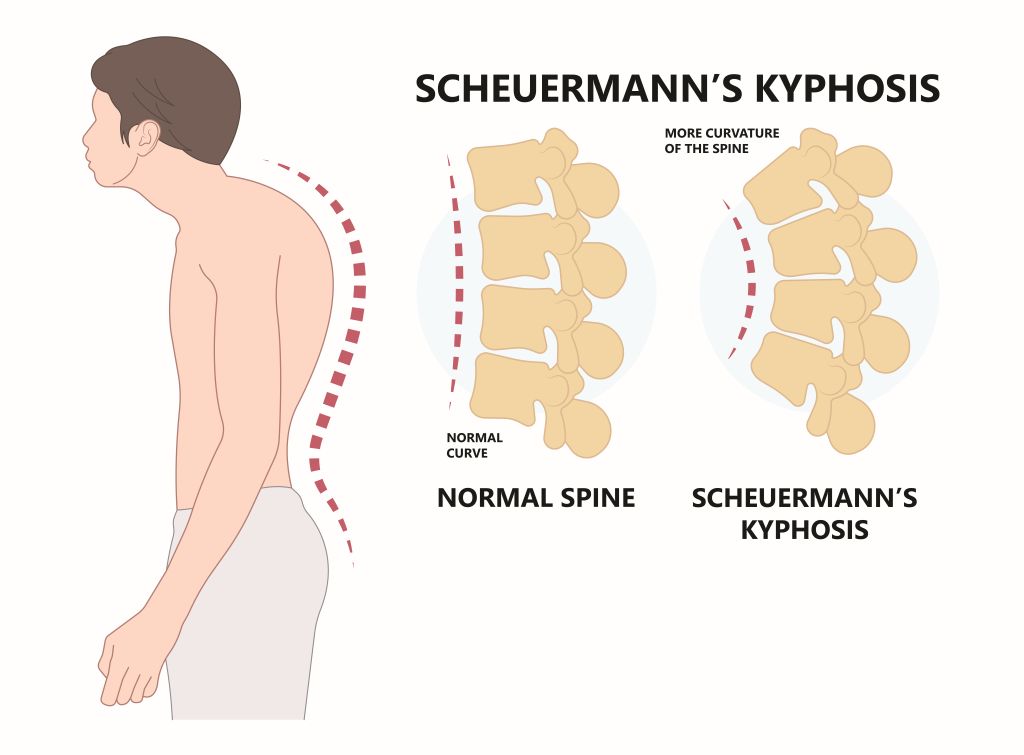Summary
Scheuermann’s disease, also known as juvenile kyphosis, is a developmental disorder that affects the spine, particularly during the growth spurt of adolescence. It is classified as a type of kyphosis, a condition characterized by an excessive forward rounding of the upper back, leading to a noticeable hunchback appearance. It can cause discomfort, pain, and changes in appearance if left untreated. Early detection and appropriate treatment, such as physical therapy, bracing, and, in severe cases, surgery, can significantly improve the quality of life for those affected by this condition.
What is Scheuermann’s Disease?
Scheuermann’s disease, also known as juvenile kyphosis, is a developmental disorder that affects the spine, particularly during the growth spurt of adolescence. It is classified as a type of kyphosis, a condition characterized by an excessive forward rounding of the upper back, leading to a noticeable hunchback appearance. Unlike some other spine-related issues, Scheuermann’s disease primarily impacts the thoracic (upper) spine, although it can also affect the lumbar (lower) spine in some cases.
Causes
The exact cause of Scheuermann’s disease is not fully understood, but researchers believe that both genetic and environmental factors play a role in its development. Some potential causes include:
- Genetics: There is evidence to suggest that Scheuermann’s disease may have a hereditary component. If there is a family history of the condition, the risk of developing it may be higher.
- Growth Spurt: Scheuermann’s disease often becomes apparent during adolescence when the body undergoes rapid growth. During this period, the vertebrae (the bones that make up the spine) may grow unevenly, leading to curvature.
- Poor Posture: Prolonged periods of poor posture, especially during adolescence, may contribute to the development of Scheuermann’s disease. Constant slouching or incorrect body alignment can put additional stress on the spine, leading to curvature.
Prevalence
Scheuermann’s disease has a prevalence ranging from 1% to 8% in the United States, with a male to female ratio of at least 2:1. It is most commonly diagnosed in adolescents aged 12 to 17 years.
Symptoms
Scheuermann’s disease can present various symptoms, which may range from mild to severe. Some of the most common signs include:
- Round Back: One of the most noticeable symptoms is the development of an exaggerated rounding of the upper back, giving it a hunchback appearance.
- Back Pain: Patients with Scheuermann’s disease often experience persistent back pain, which can be dull and aching or more severe.
- Stiffness: The spine’s curvature can lead to decreased flexibility and stiffness, making it challenging to perform certain movements.
Treatment
The treatment for Scheuermann’s disease depends on the severity of the condition and the age of the patient. In mild cases, conservative approaches are often effective, while more severe cases may require surgical intervention. Some common treatment options include:
- Physical Therapy: Physical therapy is often recommended to strengthen the muscles around the spine, improve flexibility, and promote better posture. Therapists can also teach patients how to maintain correct body alignment during daily activities.
- Pain Management: Over-the-counter pain relievers or nonsteroidal anti-inflammatory drugs (NSAIDs) can help manage pain and reduce inflammation.
- Bracing: In some cases, especially during the growth spurt, wearing a back brace may be beneficial to control the progression of the curvature. The brace provides external support to the spine and can help align it properly.
- Surgery: For severe cases where conservative treatments are ineffective or if the curvature continues to progress, surgery may be considered. The surgical procedure involves correcting the curvature and stabilizing the spine with metal implants.
Takeaways
Scheuermann’s disease is a condition leads to an exaggerated rounding of the upper back, causing a noticeable hunchback appearance. While the exact cause remains unclear, both genetic and environmental factors are believed to contribute to its development. Symptoms of Scheuermann’s disease can range from mild to severe and may include round back, persistent back pain, and stiffness. Fortunately, various treatment options are available, depending on the severity of the condition. Conservative approaches, such as physical therapy, pain management, and bracing, are effective for many individuals, while surgery may be necessary for more severe cases. Early diagnosis and timely intervention are crucial for better outcomes, enabling patients to lead active and fulfilling lives with improved posture and reduced discomfort.
